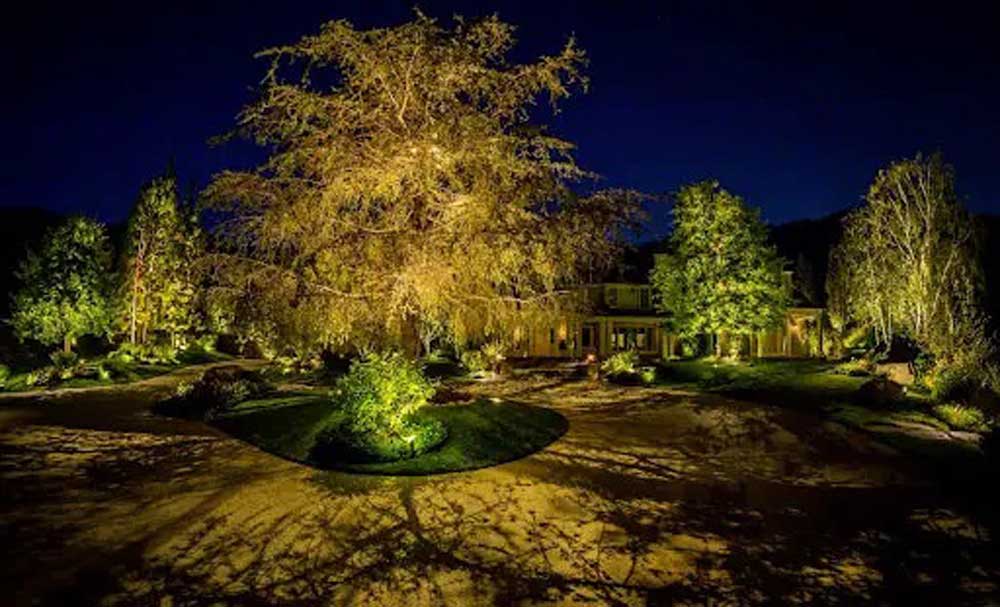Landscape lighting brings a touch of serenity to your outdoors- transforming it into an enchanting space. It allows you to prolong the enjoyment of the garden well after dark. With various lighting techniques, you can admire the beauty of blooming perennials even after sunset.
Among the myriad of lighting effects, moonlighting, by simulating the ethereal silvery glow of the moon, tends to be the most natural and captivating option.
Scroll on to learn more about moonlighting from trees and practical ways to create the effect.
So, What is Moonlighting?
Moonlighting involves using downlighting fixtures mounted high up trees. This way, light diffuses through the leaves and branches illuminating the surface below with a gentle glow similar to moonlight, even on moonless nights.
This is a subtle way to illuminate flower beds, herbaceous borders, a putting green, lawn, a path, a driveway, patios, terraces, or alfresco dining areas. If you have a water feature like a pool or pond, moonlighting creates a shimmering effect on the reflective surface.
Beyond the aesthetic appeal, moonlighting enhances outdoor safety and security. Ideally, you want the moonlit effect near high-traffic areas such as a path or deck where you can fully appreciate it and use it for navigation.
And with pendant downlights, the light and gentle shadows dance gracefully under the sway of the wind.
How to create Moonlighting
Moonlighting requires strategic placement of bullet or pendant downlights in the secondary canopy, well above the lower branches to cast a branching pattern below.
Tall trees with an open structure and moderate branching are perfect candidates for moonlighting as the fixtures can be mounted high in the branches. The foliage on some evergreens may be too dense for the beams of light to penetrate and reach the surface below.
Mount the luminaires at least 20 feet and ideally 30 feet up into the tree pointed downwards at an angle not exceeding 30° off the vertical plane. This keeps the light source out of sight as the light gracefully filters through the branches and leaves.
Positioning the fixtures above the lower branches of trees produces a dappled effect on the ground, adding interest and drama to the scene.
Light any tree with at least two fixtures and up to 8 or more for very large trees. Aim the fixtures so that the light beams crisscross on their way down. A single light fixture will not achieve a captivating moonlit effect and result in an overly harsh illumination.
The light fixtures should be concealed from view. This can be through discreetly tucking them into the tree canopy, using a glare shield (shroud) or hex baffle (honeycomb filter) to minimize glare. The moonlit effect will be compromised if guests can see the light source. The focus should be on the lighting effect, not the source.
To moonlight a grove of trees, use the same techniques, but alternate the direction in which the light is thrown in alternate trees. For an added sense of perspective, illuminate more brightly a clearing some distance into the grove.
Fixture Selection
When moonlighting trees, it is essential to use softer lighting, cool color temperature, and a beam spread of around 45°. A slightly blue hue color temperature, between 4000 and 5000 K (blue-white), works best. Natural moonlight is subtle, about 0.01-foot candles with a 4000K color temperature.
Avoid over-lighting by using too many fixtures or too high an intensity (lumen output), as the effect may be too harsh.
Installation
Moonlighting from an overhead tree requires extra effort to install the luminaires high up in the tree and to hide electrical wiring.
Do not staple the wire to the tree as some wire staples may harm the tree. Furthermore, staples and wire affixed this way may get absorbed by the tree as it grows, pinching the wires and causing a short circuit. Instead, utilize only stainless steel screws and zip ties that will break away as the tree grows.
Ensure regular maintenance for your moonlighting setup for optimal performance of the system
To Wrap Up
Simulating moonlighting is both an exercise in creativity and expertise. When executed properly, the moonlit effect is subtle and unobtrusive.
Do not limit yourself to moonlighting alone. Combining moonlighting with uplighting the trunk of the trees ties the tree to the ground. Uplifting involves positioning the light fixture close to the base of the trees to cast light upwards the tree trunk to highlight the texture and color of the bark. Moonlighting alone creates the impression of a tree hovering mid-air.
By working with a professional, you bring your vision to life creating a breathtaking nightscape that leaves a lasting impression on both guests and yourself.


